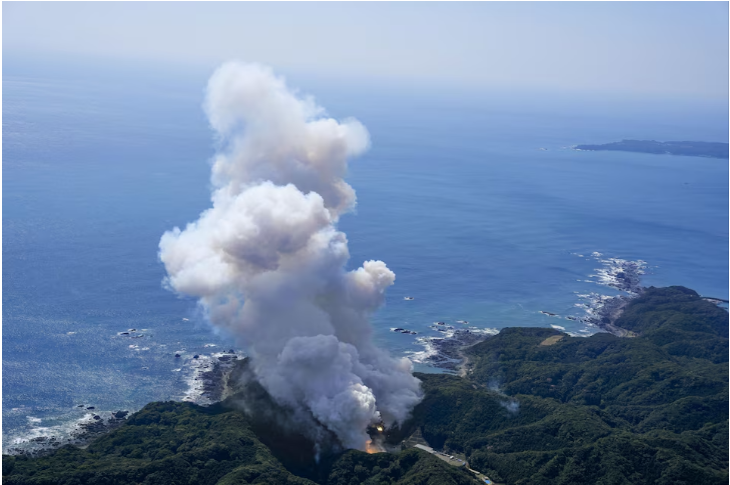Japan Space One launched Kairos, a tiny solid-fuel rocket, on Wednesday, hoping to become the country’s first Japanese business to send a satellite into orbit. However, the rocket burst shortly after takeoff.
The setback for Space One and the Japanese rocket business coincides with increased government and investor backing for the industry in the face of a surge in demand for commercial satellites and a national security buildup.
Observed on local media livestreams, the 18-meter (59-foot) rocket burst five seconds after takeoff, producing a massive cloud of smoke, a fire, rocket pieces, and sprays of firefighting water close to the launch site on the point of the hilly Kii peninsula in western Japan.
“The rocket decided that it would be difficult to complete its mission, so it ended the flight,” stated Masakazu Toyoda, head of the business.
Space One simply promised to look into the incident; it did not say what caused self-destruction after the first-stage engine began or when the firm will launch the next Kairos.
According to the business, the rocket self-destructs when it detects problems in its flight route, speed, or control system that may cause a collision that puts people on the ground in risk. The launch is also highly automated, needing just a few hundred ground personnel.
Toyoda said during a press conference, “We don’t use the word ‘failure,’ because each trial brings us… new data and experience for another challenge.”
The Wakayama prefecture governor, Shuhei Kishimoto, informed reporters that there were no casualties in the vicinity of the launch pad and that the fire had been put out.
In the event that intelligence satellites in orbit go out, Kairos carried an experimental government satellite that can take their place.
The launch was originally scheduled for Saturday, but Space One had to reschedule it after a ship approached the surrounding restricted maritime region.
Japan is a relatively tiny participant in the space race, but its rocket engineers are working feverishly to produce more affordable vehicles in order to meet the country’s government’s and other international clients’ rising demand for satellite launches.
A group of Japanese businesses, including the state-backed Development Bank of Japan, Canon Electronics (7739.T), the aerospace engineering division of IHI (7013.T), construction company Shimizu (1803.T), and others, came together in 2018 to form the Tokyo-based Space One. Majority owners of minority stakes include Japan’s largest banks, Mitsubishi UFJ (8306.T) and Mizuho (8411.T), both of which open new tabs.
Following Wednesday’s unsuccessful launch, shares of IHI dropped as much as 2%, and shares of Canon Electronics tumbled as much as 13%.
Space One hopes to launch 20 rockets annually by the late 2020s and desire to provide “space courier services” to both local and foreign customers. The firm reported that orders for its second and third scheduled excursions, including one from an international consumer, had been filled despite the fact that Kairos’ initial launch window had been delayed four times.
With three stages of solid fuel engines and a liquid fuel post-boost stage engine, Kairos aims to reach low-Earth orbit with payloads up to 250 kg.
Although business president Kozo Abe stated that Kairos is “competitive enough” versus American rival Rocket Lab (RKLB.O), opens new tab, Space One does not reveal the cost of Kairos’ launch.
Since 2017, Rocket Lab has launched over 40 Electron mini rockets from New Zealand, with an estimated flight cost of $7 million per. Numerous Japanese businesses, such as iQPS (5595.T), opens new tab, and Synspective, as well as orbital debris-removal firm Astroscale, have employed Electron for their missions.
Japan is working with the US to revive its own aerospace sector in an effort to compete with China and Russia in both technology and military prowess.
The state-funded Japan Aerospace Exploration Agency (JAXA) launched the H3, its new, economical flagship rocket, successfully last month. This year, JAXA successfully carried out a historic “pinpoint” lunar landing. By 2030, the H3 is expected to send around 20 satellites and probes into space.
But prior to then, JAXA had experienced a number of failures. The first launch of H3 last year and the second flight of Epsilon, a smaller rocket, in 2022 both ended in failure. At JAXA’s testing facility, an enhanced Epsilon engine burst in July 2023.
With its MOMO series of rockets, Interstellar Technologies launched Japan’s first privately produced rocket in 2019, but without a full-scale satellite payload.
In an effort to increase intelligence capabilities, the government built satellite constellations last year, promising “comprehensive” assistance and opening a new tab for space businesses with technologies vital to national security.
Japan’s defense ministry announced on Friday that it had reached an agreement with Space One to test fuel-efficient methane engines in order to increase the cargo capacity of its rockets.
“Rocket Lab, too, did not achieve its mission at the inaugural (Electron) flight, but it went on to launch three rockets in its second year,” added Toyoda. “We must compete with this firm; we cannot stop here.
I am a dedicated student currently in my seventh semester, pursuing a degree in International Relations. Alongside my academic pursuits, I am actively engaged in the professional field as a content writer at the Rangeinn website.







